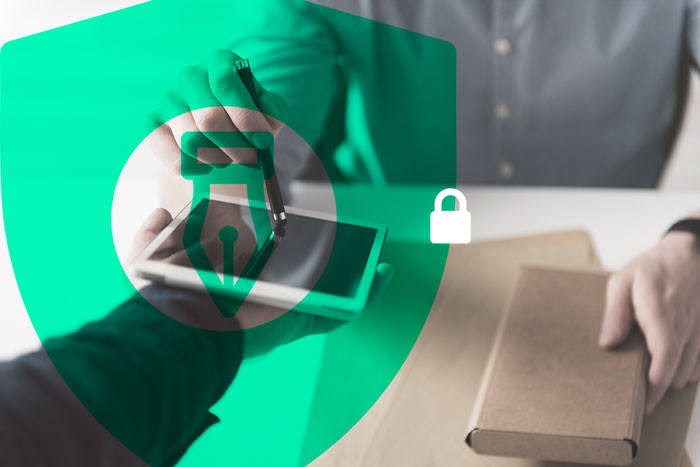Digital signatures offer a convenient way to sign documents in today's digital age. Unlike with a wet signature scan that is then physically stuck to the document, digital signatures have a number of advantages that make them more convenient not only for the signatory, but also the sender of the document.
Not only that, the use of digital signatures can help improve workflow efficiency, maintain the security of signed documents, and save company costs. How can digital signatures provide so many benefits? Here’s how.
First, Let’s Understand How Digital Signatures Work
To make it easier to understand how easy it is to use digital signatures, we must first understand how they work. As has already been mentioned, digital signatures are not wet signatures that are scanned and then “affixed” to a digital document. Unlike a scanned signature, a digital signature contains an asymmetric cryptography system.
The asymmetric cryptographic system is designed with what is known as a public key infrastructure (PKI). The PKI consists of a public key and a private key. This paired system can be connected mathematically to ensure the validity of the digital signature.
The private key is uniquely designed for each digital signature user and can be accessed only by the signatory. The public key is attached to the digital certificate, along with the digital documents that have been encrypted by the private key. The information contained in the public key enables the person’s digital signature to be validated.
This means that by using a public key embedded in a digital certificate, the recipient of the document can validate the signatory's digital signature. Thanks to a uniquely structured combination of public and private key technology, no two digital signatures will be the same, making them difficult to forge. Thanks to this capability, the digital signature will make it easier for you to guarantee the validity of the data stated on the electronic signed document.
Easy Access for Signatories as well as for Document Senders
Electronic signatures also provide convenience in terms of access. Because it is electronic, this unique signature can be accessed from anywhere, be it computers, laptops, tablets, or even smartphones. The signing process can be done more quickly and practically. When making agreements or signing contracts, for instance, the parties involved do not need to meet in person.
Digital signatures also benefit the dispatcher, too. For example, a secretary might typically need to organize the dispatch of signed documents from his or her superior to other parties to be signed by them.
Under this conventional signing process, the sender must first print out the physical documents and then go around chasing all the parties concerned for wet signatures. If all the signatories are under the same roof and working for the same company, this might not be such a problem. However, if external parties such as clients or vendors are involved, the person needs to physically travel to their location or courier the physical document. This all takes time and money.
It is different if the company uses a digital signature. The sender can collect signatures from all related parties by sending a digital version of the document via email. This is naturally much more practical, because it cuts out the need for printing and dispatch of the documents.
Digital Signatures Help Speed up The Company's Workflow
When you use a digital signature you don't have to send conventional physical documents - whether by post or hand delivery - so the document-signing process can take place much faster. Processing a physical document requires printing first, and then dispatch, and, of course you then have to sit and wait for the document to be returned. A lot of time is wasted due to an inefficient workflow.
Digital signatures make the workflow more efficient, as the signature process can be completed in just a few minutes, leaving you and your team with more time to spend on more productive activities - a presentation deck, perhaps, or a financial budget, or a marketing strategy. A higher level of productivity has a positive impact on your company’s growth
Practical Electronic Signature Identity Verification
As well as acting as a way of demonstrating one’s agreement to the terms of the agreement or contract, a signature also shows the identity of each party involved. To ensure that a signature is authentic and made by the signatory himself, and is not faked or misused, identity verification is required. However, if you use a wet signature, how can you achieve this? The only way is for the signatory to be present in person. This can make things difficult.
A digital signature makes it easier to verify your identity. Ideally, digital signatures are protected with a biometric authentication system for users. This means that the system uses a person's biological identity to carry out verification, such as voice recording, fingerprint recording, or facial photograph.
For example, VIDA Sign’s biometric authentication system uses face scanning or face recognition technology. Facial biometric data is saved and can be used again whenever you access it. Of course, access can only be granted if the saved biometric data matches the data of the person accessing the system.
In other words, a person's identity can only be officially verified if the data they provide is suitable. Conversely, if the data provided does not match the recorded data, then the person’s identity will not be verified and he or she will not be able to access the signature. The existence of a biometric authentication system for digital signatures allows you to easily verify the identity of the accesser without having to remember passwords or codes.
Ease of Maintaining Document Security and Integrity
Wet-signed documents stored in a room are prone to loss, either because they are stolen or mislaid. If a document is lost, there is a risk that the document could be duplicated and misused. A digital signature eliminates the possibility of serious problems like this.
As already explained, the way digital signatures work involves private and public keys that are incorporated in the PKI protocol. The private key is only given to someone who has the right to access a digital document. In other words, only that person knows the private key. Private keys are paired with public keys that are attached to digital documents. So, if the private key does not match the public key of the document, the party concerned will not be able to access the document.
This will increase the security of documents and minimize the risk of misuse. In addition, documents stored in digital form will be easier to store in data centers and cloud computing so they are not easily lost or mislaid. Coupled with the biometric authentication system as described in the previous point, the security and integrity of documents can be guaranteed.
Electronic Certificates Make it Easier to Control Documents
The PKI protocol contained in a digital signature is actually a form of a digital certificate. As the name implies, a digital certificate contains a digital signature and an identity that shows the legal status of the parties in digital transactions. Digital certificates can only be issued by third parties called electronic certificate administrators (PSrE) or certificate authorities.
Apart from the PKI protocol, another form of digital certificate is the secure socket layer (SSL), which uses cryptographic keys. This key can only be used during the verification process to access a certified server. For example, if you log in to a server using a digital signature, but the server is not registered, you will get a warning. As a result, document or data security can be maintained.
Thanks to this digital certificate, documents that are digitally signed are easier to trace or monitor. When you sign a digital document, the digitally certified signature will assign a unique code to it. This code is retained after the document is shared, so if someone irresponsible tries to access or make changes to the document, you will know immediately.
Help Save Company Expenses
When you use a wet signature on a physical document, you are actually spending a lot of money without realizing it. Paper, document printing, ink, printer maintenance - each of these has a cost.
If a document needs to be signed by people who are in different locations, you will have additional costs. Money must be spent to ensure that the document is received by the person concerned, whether it is transportation costs or shipping expedition costs. The further away the location and the more often you send documents, the greater the costs.
Not only that, you also still have to prepare expenses for administration. To keep the signed physical documents in good condition, you need a filing system. You will likely have a dedicated employee for this.
It is no secret that in order for a company to grow, efficiency in operational expenditure is paramount. Thankfully, a digital signature helps you save on company expenses. You no longer need to print documents, expedite them, and so on. Documents can be stored digitally and sent via email.
So, now you know that digital signatures are easier than wet signatures, in terms of efficiency, security, and even cost savings.
However, to ensure you can get the most of all these conveniences, make sure you use a digital signature that is equipped with a digital certificate such as VIDA Sign. The digital certificate provides layered security for signed digital documents so that the risk of misuse can be minimized.
In addition, make sure that the digital signature provider has received official certification from the Financial Services Authority (OJK). As long as you use VIDA Sign, you don't need to worry about this because VIDA Sign is officially certified by the OJK through decree number S-276 / MS.72 / 2019 and is registered as a provider of financial technology by Bank Indonesia (BI).
Baca juga: Prospek dan Masa Depan Tanda Tangan Elektronik di Indonesia

.png)


